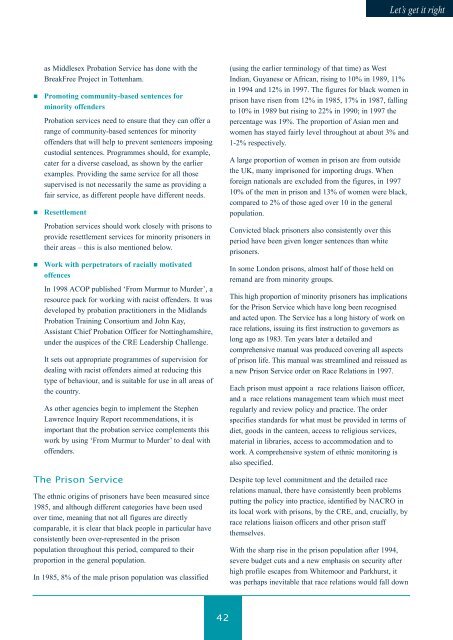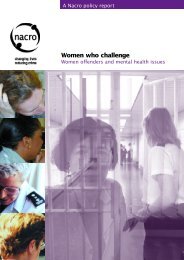Let's get it right: race and justice 2000 - Nacro
Let's get it right: race and justice 2000 - Nacro
Let's get it right: race and justice 2000 - Nacro
- No tags were found...
Create successful ePaper yourself
Turn your PDF publications into a flip-book with our unique Google optimized e-Paper software.
Let’s <strong>get</strong> <strong>it</strong> <strong>right</strong>as Middlesex Probation Service has done w<strong>it</strong>h theBreakFree Project in Tottenham.Promoting commun<strong>it</strong>y-based sentences forminor<strong>it</strong>y offendersProbation services need to ensure that they can offer arange of commun<strong>it</strong>y-based sentences for minor<strong>it</strong>yoffenders that will help to prevent sentencers imposingcustodial sentences. Programmes should, for example,cater for a diverse caseload, as shown by the earlierexamples. Providing the same service for all thosesupervised is not necessarily the same as providing afair service, as different people have different needs.ResettlementProbation services should work closely w<strong>it</strong>h prisons toprovide resettlement services for minor<strong>it</strong>y prisoners intheir areas – this is also mentioned below.Work w<strong>it</strong>h perpetrators of racially motivatedoffencesIn 1998 ACOP published ‘From Murmur to Murder’, aresource pack for working w<strong>it</strong>h racist offenders. It wasdeveloped by probation pract<strong>it</strong>ioners in the Midl<strong>and</strong>sProbation Training Consortium <strong>and</strong> John Kay,Assistant Chief Probation Officer for Nottinghamshire,under the auspices of the CRE Leadership Challenge.It sets out appropriate programmes of supervision fordealing w<strong>it</strong>h racist offenders aimed at reducing thistype of behaviour, <strong>and</strong> is su<strong>it</strong>able for use in all areas ofthe country.As other agencies begin to implement the StephenLawrence Inquiry Report recommendations, <strong>it</strong> isimportant that the probation service complements thiswork by using ‘From Murmur to Murder’ to deal w<strong>it</strong>hoffenders.(using the earlier terminology of that time) as WestIndian, Guyanese or African, rising to 10% in 1989, 11%in 1994 <strong>and</strong> 12% in 1997. The figures for black women inprison have risen from 12% in 1985, 17% in 1987, fallingto 10% in 1989 but rising to 22% in 1990; in 1997 thepercentage was 19%. The proportion of Asian men <strong>and</strong>women has stayed fairly level throughout at about 3% <strong>and</strong>1-2% respectively.A large proportion of women in prison are from outsidethe UK, many imprisoned for importing drugs. Whenforeign nationals are excluded from the figures, in 199710% of the men in prison <strong>and</strong> 13% of women were black,compared to 2% of those aged over 10 in the generalpopulation.Convicted black prisoners also consistently over thisperiod have been given longer sentences than wh<strong>it</strong>eprisoners.In some London prisons, almost half of those held onrem<strong>and</strong> are from minor<strong>it</strong>y groups.This high proportion of minor<strong>it</strong>y prisoners has implicationsfor the Prison Service which have long been recognised<strong>and</strong> acted upon. The Service has a long history of work on<strong>race</strong> relations, issuing <strong>it</strong>s first instruction to governors aslong ago as 1983. Ten years later a detailed <strong>and</strong>comprehensive manual was produced covering all aspectsof prison life. This manual was streamlined <strong>and</strong> reissued asa new Prison Service order on Race Relations in 1997.Each prison must appoint a <strong>race</strong> relations liaison officer,<strong>and</strong> a <strong>race</strong> relations management team which must meetregularly <strong>and</strong> review policy <strong>and</strong> practice. The orderspecifies st<strong>and</strong>ards for what must be provided in terms ofdiet, goods in the canteen, access to religious services,material in libraries, access to accommodation <strong>and</strong> towork. A comprehensive system of ethnic mon<strong>it</strong>oring isalso specified.The Prison ServiceThe ethnic origins of prisoners have been measured since1985, <strong>and</strong> although different categories have been usedover time, meaning that not all figures are directlycomparable, <strong>it</strong> is clear that black people in particular haveconsistently been over-represented in the prisonpopulation throughout this period, compared to theirproportion in the general population.In 1985, 8% of the male prison population was classifiedDesp<strong>it</strong>e top level comm<strong>it</strong>ment <strong>and</strong> the detailed <strong>race</strong>relations manual, there have consistently been problemsputting the policy into practice, identified by NACRO in<strong>it</strong>s local work w<strong>it</strong>h prisons, by the CRE, <strong>and</strong>, crucially, by<strong>race</strong> relations liaison officers <strong>and</strong> other prison staffthemselves.W<strong>it</strong>h the sharp rise in the prison population after 1994,severe bud<strong>get</strong> cuts <strong>and</strong> a new emphasis on secur<strong>it</strong>y afterhigh profile escapes from Wh<strong>it</strong>emoor <strong>and</strong> Parkhurst, <strong>it</strong>was perhaps inev<strong>it</strong>able that <strong>race</strong> relations would fall down42

















